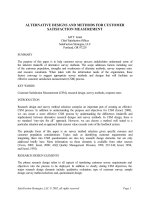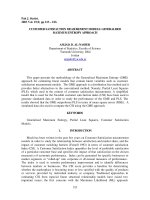CUSTOMER SATISFACTION MEASUREMENT MODELS: GENERALISED MAXIMUM ENTROPY APPROACH
Bạn đang xem bản rút gọn của tài liệu. Xem và tải ngay bản đầy đủ của tài liệu tại đây (55.93 KB, 14 trang )
213
Pak J. Statist.
2003 Vol. 19(2) pp 213 – 226
CUSTOMER SATISFACTION MEASUREMENT MODELS: GENERALISED
MAXIMUM ENTROPY APPROACH
AMJAD. D. AL-NASSER
Department of Statistics, Faculty of Science
Yarmouk University, Irbid
Jordan
ABSTRACT
This paper presents the methodology of the Generalised Maximum Entropy (GME)
approach for estimating linear models that contain latent variables such as customer
satisfaction measurement models. The GME approach is a distribution free method and it
provides better alternatives to the conventional method; Namely, Partial Least Squares
(PLS), which used in the context of costumer satisfaction measurement. A simplified
model that is used for the Swedish customer satisfaction index (CSI) have been used to
generate simulated data in order to study the performance of the GME and PLS. The
results showed that the GME outperforms PLS in terms of mean square errors (MSE). A
simulated data also used to compute the CSI using the GME approach.
KEYWORDS
Generalised Maximum Entropy, Partial Least Squares, Costumer Satisfaction
Models.
1. INTRODUCTION
Much has been written in the past few years on Customer Satisfaction measurement
models in order to study the relationship between satisfaction and market share, and the
impact of customer switching barriers (Fornell 1992) in terms of customer satisfaction
Index (CSI). A Customer Satisfaction Index quantifies the level of profitable satisfaction
of a particular customer base and specifies the impact of that satisfaction on the chosen
measure(s) of economic performance. Index can be generated for specific businesses or
market segments or "rolled-up" into corporate or divisional measures of performance.
The index is used to monitor performance improvement and to identify differences
between markets or businesses. The CSI score provides a baseline for determining
whether the marketplace is becoming more or less satisfied with the quality of products
or services provided by individual industry or company. Traditional approaches in
estimating CSI from especial linear structural relationship models have raised two
important issues; the first concerns with the Maximum Likelihood (ML) approach
Customer satisfaction measurement models 214
developed by Jöreskog (1973), which estimates the parameters of the model by the
maximum likelihood method using Davidon-Fletcher-Powell algorithm. The other
research issue concerns with the distribution free approach, namely, Partial Least Square
(PLS). The PLS method was developed by Wold (1973, 1975) which he calls “soft
modelling”, or “Nonlinear Iterative Partial Least Square” (NIPLAS). After several
versions in its development, Wold (1980) presented the basic design for the
implementation of PLS algorithm. In the literature, the PLS method is usually presented
by two equivalent algorithms. There are many authors who described PLS algorithms in
their articles (Geladi and Kowalski (1986), Helland (1988), Helland(1990), Lohmoller
(!989), Bremeton(1990) and Garthwaite(1994) ). Appendix A is describe the PLS
algorithm.
However, The Swedish CSI (Fornell 1992) and European’s CSI (Gronhlodt et al
2000) models are used PLS method. This paper will discuss the GME estimation
approach in solving the customer satisfaction models. A proposed method can be used to
compute CSI based on statistical information about customer satisfaction measurements
model.
2. COSTUMER SATISFACTION MEASUREMENT MODELS
Customer satisfaction model is a complete path model, which can be depicted in a path
diagram to analyse a set of relationships between variables. It differs from simple path
analysis in that all variables are latent variables measured by multiple indicators, which
have associated error terms in addition to the residual error factor associated with the
latent variable, a good examples on these models are the American customer satisfaction
index (see Figure.1) which is a cross-industry measure of the satisfaction of customers in
United States households with the quality of goods and services they purchase and use
(Bryant 1995), and the European customer satisfaction index model, which is an
economic indicator, represents in Figuer.2.
Figuer.1: The American Customer Satisfaction Framework
Perceived
quality
Perceived
Value
Customer
Satisfaction
Customer
Expectation
Customer
Loyalty
Customer
Complaints
Al-Nasser 215
Figuer.2 The European Customer Satisfaction Framework
Many researchers from various disciplines have used Linear Structural Relationship
(LISREL) as a tool for analysing customer satisfaction models. The general and formal
model of customer satisfaction can be written as a series of equations represented by
three matrix equations Jöreskog (1973):
η
(m x 1)
= Β
(m x m)
* η
(m x 1)
+ Γ
(m x n) *
ξ
(n x 1)
+ ζ
(m x 1)
(1)
y
(p x 1)
= Λ
y (p x m)
* η
(m x 1)
+ ε
(p x 1)
(2)
x
(q x 1)
=
Λ
x (q x n)
* ξ
(n x 1)
+ δ
(q x 1)
(3)
The structural equation models given in (1-3) have two parts; the first part is
structural model (1) that represents a linear system for the inner relations between the
unobserved inner variables. The second part is the measurement model (2) and (3) that
represents the outer relation between observed and unobserved or latent and manifest
variables.
The structural equation model (1) refers to relations among exogenous variables ( i.e;
a variables that is not caused by another variable in the model), and endogenous variables
(i.e; a variables that is caused by one or more variable in the model). The inner variables
in this equation, ηη which is a vector of latent endogenous variables, and ξξ which is a
vector of latent exogenous variables are related by a structural relation. The parameters,
ΒΒ is a matrix of coefficients of the effects of endogenous on endogenous variables, and ΓΓ
is a matrix of coefficients of the effects of exogenous variables (ξξ’s) on equations.
However, ζζ is a vector of residuals or errors in equations.
The inner variables are unobserved. Instead, we observe a number of indicators
called outer variables and described by two equations to represent the measurement
Image
Customer
expectation
Perceived quality
of product
Perceived
quality of
Loyalty
Perceived
value price
Customer
satisfaction
Customer satisfaction measurement models 216
model (2) and (3) which specify the relation between unobserved and observed, or latent
and manifest variables. The measures in these two equations, y is a p x 1 vector of
measures of dependent variables, and x is a q x 1 vector of measures of independent
variables. The parameters,
ΛΛ
y
is a matrix of coefficients, or loadings, of y on unobserved
dependent variables (
ηη
), and
ΛΛ
x
is a q x n matrix of coefficients, or loadings, of x on the
unobserved independent variables (
ξξ
). Moreover,
εε
is a vector of errors of measurement
of y, and
δδ
is a vector of errors of measurement of x.
The model given in (1-3) has many assumptions that may be perceived as restrictions,
and these may be treated as hypotheses to be confirmed or disconfirmed and the rational
of their specification in the model depend on methodological, theoretical, logical or
empirical considerations, these assumptions:
(i) The elements of ηη and ξξ, and consequently those of ζζ also, are
uncorrelated with the components of εε and δδ. The later are uncorrelated
as well, but the covariance matrices of εε and δδ need to be diagonal. The
means of all variables are assumed to be zero, which mean that the
variables are expressed in the deviation scores. That is,
E(η) = E(ξ) = E(ζ) = E(ε) = E(δ) = 0
E(εε`) = θ
2
ε
, and E(δδ`) = θ
2
δ
where θ
2
ε
and θ
2
δ
are diagonal matrices.
(ii) It is assumed that the inner variables (η, ξ) are not correlated with the
error terms (ε, δ), but they may be correlated with each other.
Moreover, ξ and ζ are uncorrelated. That is,
E(ηε`) = E(ξδ`) = E(ξζ`) = 0
(iii) Β is nonsingular with zeros in its diagonal elements.
Given information about the variables x
(q x 1)
and y
(p x 1)
, the objective in this article is to
recover the unknown parameters Β
(m x m)
, Γ
(m x n)
, Λ
y (p x m)
, Λ
x (q x n)
and the disturbances
ζ
(m x 1)
, ε
(p x 1)
, δ
(q x 1)
by using the GME principle.
3. GENERALIZED MAXIMUM ENTROPY (GME) ESTIMATION APPROACH
Conventional work in information theory concerns with developing a consistent
measure of the amount of uncertainty. Suppose we have a set of events {x
1
,x
2
,…,
x
k
}whose probabilities of occurrence are p
1
,p
2
,…,p
k
such that 1
1
=
∑
=
k
i
i
p . These
Al-Nasser 217
probabilities are unknown but that is all we know concerning which event will occur.
Using an axiomatic method to define a unique function to measure the uncertainty of a
collection of events, Shannon (1948) defines the entropy or the information of entropy of
the distribution (discrete events) with the corresponding probabilities P = {p
1
,p
2
,…,p
k
},
as
∑
=
−=
k
i
ii
ppPH
1
)ln()(
(4)
where 0ln(0) = 0.
The amount (–ln(p
i
)) is called the amount of self information of the event x
i
. The average
of self-information is defined as the entropy. The best approximation for the distribution
is to choose p
i
that maximizes (4) with respect to the data Consistency constraints and the
Normalization-additivity requirements. Golan et al (1996) developed GME procedure for
solving the problem of recovering information when the underling model is incompletely
known and the data are limited, partial or incomplete. Al-Nasser et al (2000) developed
the GME method for estimating Errors-In-Variables models and Abdullah et al (2000)
used the same approach to study the functional relationship Between Image, customer
satisfaction and loyalty.
3.1. RE-PARAMETERISATION
In order to illustrate the use of GME in estimating the model given in (1-3) we rewrite
this model as:
y = Λ
y
Λ
x
-1
Γ (I - Β)
-1
(x - δ) + Λ
y
(I - Β)
-1
ζ + ε (5)
where I is the identity matrix, and Λ
x
-1
is the generalised inverse of Λ
x
.
The GME principle stated that one chooses the distribution for which the information
(the data) is just sufficient to determine the probability assignment. Hence the GME is to
recover the unknown probabilities, which represents the distribution function of the
random variable. However, the unknown parameters in customer satisfaction model are
not in the form of probabilities and their sum does not represent the unity, which is the
main characteristic of the probability density function. Therefore, in order to recover the
unknowns in the model we need to rewrite the unknowns in terms of probabilities values.
In this context we need to reparametrized the unknowns as expected values of discrete
random variable with two or more sets of points, that is to say;
∑ ∑
= =
==
S
s
S
s
jksjksjksjk
bbz
1 1
1,
β
, j = 1,2,…,m , k = 1,2,…,m
∑ ∑
= =
==
L
l
L
l
ijlijlijlij
ffg
1 1
1,
γ
, j = 1,2,…,m , i = 1,2,…, n









